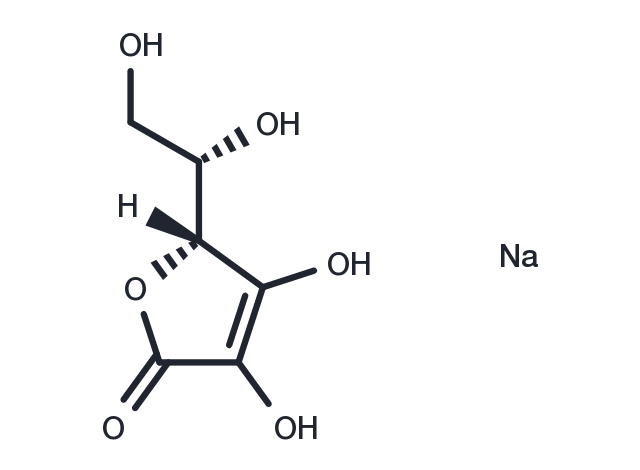Powder: -20°C for 3 years | In solvent: -80°C for 1 year
L-Ascorbic acid sodium salt (Vitamin C sodium salt) is a more bioavailable form of vitamin C that is an alternative to taking ascorbic acid as a supplement.

| パッケージサイズ | 在庫状況 | 単価(税別) | |||
|---|---|---|---|---|---|
| サンプルについてお問い合わせ | |||||
| 500 mg | 在庫あり | ¥ 10,000 | |||
| 1 g | 在庫あり | ¥ 11,500 | |||
| 1 mL * 10 mM (in DMSO) | 在庫あり | ¥ 11,500 | |||
| 説明 | L-Ascorbic acid sodium salt (Vitamin C sodium salt) is a more bioavailable form of vitamin C that is an alternative to taking ascorbic acid as a supplement. |
| In vitro | Sodium ascorbate has a growth inhibiting action only at high concentrations in cultured human neoplastic cell lines MCF-7 (breast carcinoma), KB (oral epidermoid carcinoma), and AN3-CA (endometrial adenocarcinoma). Sodium ascorbate combined with vitamin K3 demonstrates a synergistic inhibition of cell growth at 10 to 50 times lower concentrations in cultured human neoplastic cell lines MCF-7, KB, and AN3-CA, at this level separately given vitamins are not toxic. This tumor cell growth inhibitory effect is completely suppressed by the addition of catalase to the culture medium containing vitamins C and K3, suggesting an excessive production of hydrogen peroxide as being implied in mechanisms responsible for the above-mentioned effects. [1] Sodium ascorbate combined with vitamin K3 results in a synergistic effect on growth inhibition in cultured human endometrial adenocarcinoma (AN3CA) cells. [2] Sodium ascorbate results in a rapid increase in the intracellular concentration of Ca2+ ions and subsequent apoptotic cell death in HL-60 cells, characterized by cell shrinkage, nuclear fragmentation and cleavage of internucleosomal DNA to yield fragments that are multiples of 180-200 base pairs, are induced. [3] Sodium ascorbate (100 μM) induces DNA single-strand breaks in human cells, Fibroblasts and Molt-4 cells are significantly more sensitive than lymphocytes. Sodium ascorbate (50 μM) results in significant cell loss in Molt-4 cells, but not in lymphocyte and fibroblast cultures. [4] |
| In vivo | Tg rats treated with sodium?L-ascorbate show a higher incidence of carcinoma (29.6%), compared to those without sodium?L-ascorbate (15.4%). Independent of the sodium?L-ascorbate treatment, transgenic rats exhibit various kinds of malignant tumors in various organs[5]. After 12 weeks of PEITC-treatment, both simple hyperplasia and papillary or nodular (PN) hyperplasia have developed in all animals, but the majority of these lesions have disappeared at week 48, irrespective of the sodium?L-ascorbate-treatment. The same lesions after 24 weeks of PEITC-treatment have progressed to dysplasia and carcinoma, in a small number of cases by week 48, but enhancement by the sodium?L-ascorbate-treatment is evident only with simple hyperplasias and PN hyperplasias in rats[6]. |
| 植物由来 |
| 別名 | (+)-Sodium L-ascorbate, Vitamin C sodium salt, Sodium ascorbate, L-Ascorbic acid sodium, Sodium L-ascorbate |
| 分子量 | 199.11 |
| 分子式 | C6H8NaO6 |
| CAS No. | 134-03-2 |
Powder: -20°C for 3 years | In solvent: -80°C for 1 year
DMSO: 6.25 mg/mL (31.39 mM), Sonication is recommended.
H2O: 198.9 mM
You can also refer to dose conversion for different animals. 詳細
bottom
Please see Inhibitor Handling Instructions for more frequently ask questions. Topics include: how to prepare stock solutions, how to store products, and cautions on cell-based assays & animal experiments, etc.
L-Ascorbic acid sodium salt 134-03-2 Apoptosis Immunology/Inflammation Membrane transporter/Ion channel Metabolism NF-Κb Others Reactive Oxygen Species Calcium Channel Endogenous Metabolite Ca channels Vitamin C (+)-Sodium L-ascorbate Vitamin C sodium salt L Ascorbic acid sodium salt Sodium ascorbate L-Ascorbic acid sodium inhibit Inhibitor Ca2+ channels L-Ascorbic acid LAscorbic acid sodium salt Vitamin C sodium Sodium L-ascorbate inhibitor
